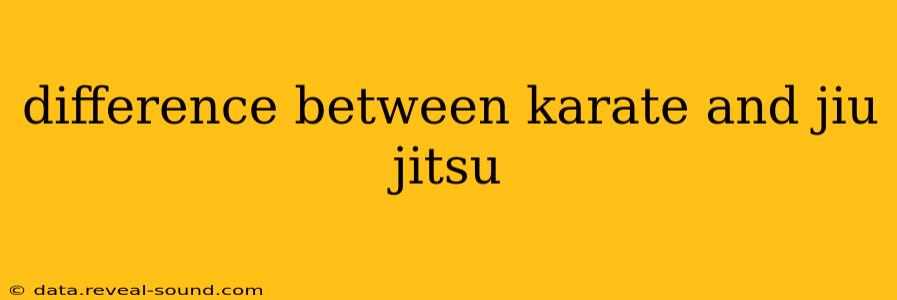Karate vs. Jiu-Jitsu: Unveiling the Key Differences
Karate and Jiu-Jitsu, while both celebrated martial arts, differ significantly in their techniques, philosophies, and training methodologies. Understanding these differences can help you choose the martial art best suited to your interests and goals. This comprehensive guide will explore the core distinctions, answering common questions many aspiring martial artists have.
What is the Main Difference Between Karate and Jiu-Jitsu?
The most fundamental difference lies in their primary focus. Karate emphasizes striking techniques, utilizing punches, kicks, blocks, and open-hand strikes to disable an opponent from a distance. Jiu-Jitsu, on the other hand, prioritizes grappling and ground fighting. Its techniques revolve around holds, submissions (like joint locks and chokes), and takedowns, often aiming to control and subdue an opponent on the ground.
What are the Key Techniques Used in Karate?
Karate boasts a diverse range of striking techniques. These include:
- Kihon (Basics): Fundamental stances, punches, blocks, and kicks forming the foundation of Karate training.
- Kata (Forms): Prearranged sequences of movements simulating self-defense scenarios, improving coordination and technique.
- Kumite (Sparring): Controlled sparring sessions allowing practitioners to apply techniques and develop combat skills.
Different Karate styles (like Shotokan, Kyokushin, Goju-ryu) may emphasize certain techniques more than others, impacting the overall style and training methods.
What are the Key Techniques Used in Jiu-Jitsu?
Jiu-Jitsu techniques are centered around grappling and ground fighting:
- Takedowns: Throws and sweeps designed to bring an opponent to the ground.
- Guard Passing: Techniques to control the opponent’s guard and establish a dominant position on the ground.
- Submissions: Joint locks (e.g., arm bars, leg locks) and chokes to force a tap-out from the opponent.
- Escapes: Techniques to break free from holds and unfavorable positions.
Brazilian Jiu-Jitsu (BJJ) is the most widely known form, with other variations existing as well.
Which Martial Art is Better for Self-Defense?
The "better" martial art for self-defense depends heavily on individual preferences and potential scenarios. Karate's striking techniques are effective at a distance, allowing you to keep an attacker at bay. However, Jiu-Jitsu excels in close-quarters combat and ground fighting, crucial if you're taken down. A well-rounded self-defense approach might incorporate elements from both disciplines.
Which Martial Art is Better for Fitness?
Both Karate and Jiu-Jitsu offer excellent fitness benefits. Karate's dynamic movements and striking techniques provide a great cardiovascular workout, improving stamina and flexibility. Jiu-Jitsu focuses on strength, endurance, and flexibility, as grappling demands significant physical exertion. The choice ultimately depends on your preferred style of training and fitness goals.
Is Karate or Jiu-Jitsu Easier to Learn?
The ease of learning either martial art depends on individual aptitude, prior experience, and commitment. Both require dedication, discipline, and consistent practice. Some find the striking techniques of Karate more intuitive, while others prefer the grappling aspects of Jiu-Jitsu.
Which One is More Effective in a Real Fight?
Effectiveness in a real fight hinges on many factors, including the practitioner's skill level, the opponent's abilities, and the specific circumstances. Both Karate and Jiu-Jitsu can be highly effective in real-world self-defense situations. The most effective martial art is the one you train consistently and master.
Ultimately, the best choice between Karate and Jiu-Jitsu depends on your individual goals, physical preferences, and learning style. Consider trying introductory classes in both disciplines to determine which better suits your needs and aspirations.
